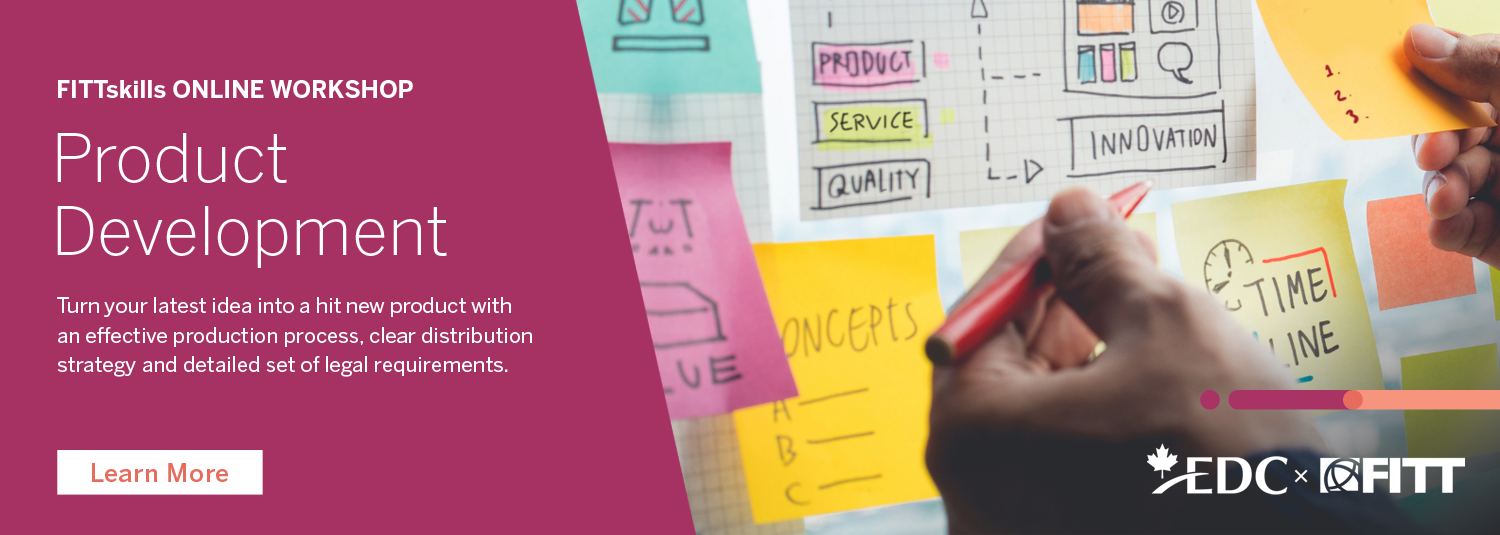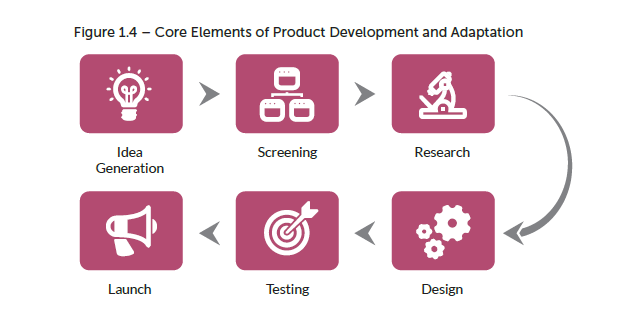
Now that you’ve put in all of the hard work in researching, designing and testing your newly adapted product(s), you’re ready for the big payoff – time to launch them into the market and bring in the revenue!
But before you pop open the champagne, you need to make sure you stick the landing on this launch. So what do you need to do to get it right?
Read on for an outline of the steps to a successful launch, and a summary of the whole product adaptation process.
This article series explores the four general stages of product development:
- Innovation
- Design
- Testing
- Launch or commercialization
This article will focus on Stage 4: Launch or commercialization!
Organizations launching new (or adapted) products may start in a few selected markets with a small run of product, and a sales and marketing campaign that will monitor product uptake. This initial sales data can be used to determine whether to proceed with more production, to increase both domestic and foreign markets, and to expand the sales and marketing program.
Want to learn more about tailoring design considerations and policies to suit customer preferences? Check out the FITTskills Product Development online workshop!
10 Practical Steps for a Successful Product Launch
- Start early: Begin outreach activities six to eight weeks before the official launch date to maximize opportunities for coverage.
- Make the product available to influencers: Offer the product to existing customers, prospects or bloggers with online presence to garner early reviews and articles.
- Brief industry analysts: Promote your product early in the process and present a compelling case for your offering.
- Create buzz online: Use social media to generate interest with strategic “coming soon” and “sneak peek” posts along with photos or video to build interest.
- Plan a low-key release: The official launch date could simply be when the product is available to customers, rather than a splashy launch event.
- Have a rolling release: Publish regular content about the product, its benefits, case studies and reviews to build momentum in sales and marketing.
- Grab their attention: During the release cycle, do something unusual that will make people talk about the product, such as a witty video, a clever infographic or a publicity stunt at an industry event.
- Involve partners: Have your marketing team engage with stakeholders who will benefit from a successful launch (such as your distribution channel) to encourage the informal promotion of the product, and spread the word about the product release.
- Make it easy for customers: Offer free trials, downloads, product videos and demos so consumers can learn more about the product.
- Focus on meaningful engagement: Rather than focusing on a general social media audience, connect with the users who are talking about your product and explore how they might promote it within their social circles
The development and commercialization of totally new products is very risky, even when an unmet need is identified. It may require a significant investment of resources, but if carried out well it can also reap significant returns.
With a totally new product there is no ability to ride the success of an existing product platform. A new product is launched and initiates the very beginning of a product life cycle. All aspects of the global value chain need to be carried out, generally on a small scale, increasing in scope with the growth and success of the product.
Elements of Product Development and Adaptation Processes
There are other product development and adaptation processes that can be used. Typically, they include the following nine steps, although some variation in steps may occur depending on the organization’s products.
9 Typical Steps in Product Development and Adaptation
| Product development and adaptation steps | Description |
| 1. Opportunity identification | Identification and scoping of a market or markets a company might enter. Companies can use a number of ways to identify the new opportunities including:
· Road mapping · Competitive intelligence analysis · Customer trend analysis Companies can use formal or informal techniques of identifying opportunities from research on existing businesses to brainstorming with employees. |
| 2. Idea generation | Development of ideas for new products or adaptations based on a continuous, systematic approach for identifying and analyzing product opportunities. |
| 3. Idea screening | Elimination of unsound ideas prior to allocating resources through the assessment of the idea, based on:
· Consumer benefit · Current and expected competitive pressure · Industry sales and trends for the basis of product idea · Size and growth forecasts for market · Technical feasibility of production · Profitability, e.g. costand pricing |
| 4. Concept development and product testing | Concept testing, presentation of ideas and/or prototype to consumers to measure attitudes and intentions, and to improve prototype based on user feedback, e.g. “beta testing”. |
| 5. Market strategy development | Marketing plan that outlines the planned price distribution strategy and marketing budget for the first year. The marketing strategy should examine the market, planned product positioning, sales, market share and profit goals for first two years. It should be aligned with the organization’s overall marketing strategy to ensure there are no conflicts or brand repercussions. |
| 6. Business / financial analysis | An examination of the financial and business feasibility of the product based on estimates for a selling price, sales volume based on market size, and breakeven and profitability points. |
| 7. Market testing | A short-term placement of the product for sale in a small, limited market to gather data and observations on actual performance under the proposed marketing plan, e.g. limited launch. |
| 8. Technical implementation | Implementation of changes in production, or scaling up of manufacturing processes to produce new or adapted product. |
| 9. Product launch / Commercialization | Implementation of the complete marketing plan, full production and logistics. |
The emphasis and resources spent on each of these steps will depend on the characteristics of the organization, the product type and the market. Although the ability to screen out ideas will depend on the quality and nature of information collected, research is separated here as a distinct stage to highlight its importance.
Organizations should not underestimate the value of primary market research in the early stages of development and adaptation.
It is at this stage where the processes of product development and adaptation start to strongly align with the marketing function of an organization. It is through talking to potential customers that ideas for new and adapted products can start to be narrowed.

Figure 1.4 – Core Elements of Product Development and Adaptation – originally published in FITTskills Products & Services for a Global Market ebook.
Check out the rest of the product adaptation article series:
1. Innovation
2. Design
3. Testing







disqus comments